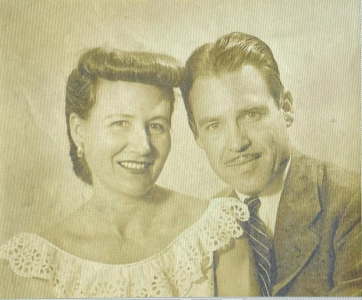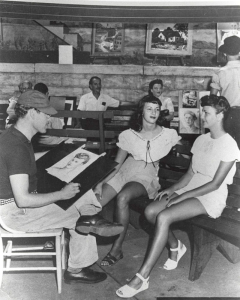

Biography
Harry Louis Freund was born in 1905 in Clinton, MO. His mother was an artist who made copies of paintings, and his uncle painted miniature portraits, so he had an early introduction to art. He studied art first at the University of Missouri (1923-1925) and then at the St. Louis School of Fine Arts at Washington University (1925-1929). In 1930 he received a scholarship for 14 months of study in Paris, which he spent at the Académie Colarossi and Académie de la Grande Chaumière.
Returning to the United States, Freund worked as an illustrator for a New York publishing house (1931-1933) until the Depression forced him to return home to Missouri. He found employment in New Deal programs and drove his Model T through the Ozarks, creating paintings that attempted to capture the spirit of rural America. His paintings were exhibited and won awards as early as 1927 and continuing through the 1940s.
In 1933 Freund painted a mural for State of Missouri exhibit at Chicago World's Fair. And he received commissions for six Post Office murals: "Wheat Farming and Chicken Hatcheries" (1936) in Clinton, MO; "Arrival of the First Train in Herington - 1885" (1937) in Herington, KS; "Agriculture and Varied Industry" (1938) in Windsor, MO; "From Timber to Agriculture" (1939) in Heber Springs, AR; "Early Days and First Post Office in Pocahontas" (1939) in Pocahontas, AR; and "The Last Home of the Choctaw Nation" (1940) in Idabel, OK. Except for the Clinton, MO mural, which was lost, Freund's other Post Office murals are still on display, although some have been moved from their original locations.
In 1938 Freund became the artist in residence at Hendrix College in Conway, AR. At Hendrix he encouraged the notion of art for all people and the integration of art across the curriculum. His paintings of cabins, crossroad stores and other rural scenes inspired his colleague Paul Farris to capture the vernacular architecture of Arkansas in his photography.
Freund had met the artist Elsie Bates in 1936. He acquired the former home of Carrie Nation in Eureka Springs, AR, which he and Elsie were married in 1939. Their marriage was to prove fruitful for the development of art in Arkansas. While Louis's focus was on painting, Elsie painted and created some extremely interesting jewelry, which Louis dubbed "Elsaramics." After spending a year at Princeton on a Carnegie Institute fellowship (1940-1941), Louis and Elsie founded the Art School of the Ozarks in Eureka Springs, a summer school that they operated from 1941-1951. Louis taught painting and drawing, while Elsie taught crafts (weaving and design). Their efforts drew other artists to the area and helped develop Eureka Springs as a year-round artists community.
In 1940 Louis founded the art department at Little Rock Junior College (now the University of Arkansas at Little Rock). He served as an artist in residence there from 1940-1942. Simultaneously he worked as the head of the art department at Henrix from 1941-1946.
During the war years Louis claimed conscientious objector status and was assigned to camps in Arkansas, where he painted murals to help educate illiterate recruits. Elsie organized an exhibit for Henry Sugimoto, an artist of Japanese descent who was interned in Arkansas from 1942-1945.
Postwar, Louis became an itinerant portrait painter across the Midwest. He and Elsie spent 1946-1947 studying at the Colorado Springs Fine Arts Center. He did illustrations for the Ford Motor Company in 1948 and also worked for Crowell Publishing. Following a particularly brutal winter, the couple decamped for Deland, FL, where Louis taught at Stetson University. He headed the Stetson art department from 1951-1959, punctuated by grants to travel to Mexico (1953) and Central America (1959). From 1959-1967 Louis was an artist in residence at Stetson, spending winters in Florida and summers in Eureka Springs. In Florida he was president of the Florida Artist Group. Louis and Elsie founded the Florida Craftsmen Group, and Louis served as it president. In Eureka Springs the couple established the Eureka Springs Art Gallery. And, through the Freund Trust, they donated many of their works to churches and public facilities across Arkansas, Florida and Missouri. Louis died in 1999, and Elsie died in 2001.


Critical Analysis
Freund's art covered five broad themes: European landscapes, American genre painting, anti-war protest, regional American landscapes, and Christian subject matter. His best-known work is represented by his murals and easel paintings of rural Arkansas - classics of the American Scene. Less well known, but very striking, are the paintings he did during and after World War II. They reflect his horror of war and convey this horror in a very visceral manner.
Murals
- Heber Springs, Arkansas - Municipal Building: From Timber to Agriculture
- Jonesboro, Arkansas - Arkansas State University Museum: Early Days and First Post Office in Pocahontas
- Herington, Kansas - Post Office: Arrival of the First Train in Herington - 1885
- Windsor, Missouri - Post Office: Agriculture and Varied Industry
- Idabel, Oklahoma - Museum of the Red River: The Last Home of the Choctaw Nation
References
- art@hendrix! 1935-1959 (Windgate Museum of Art at Hendrix College). Article by Victoria Chandler.
- H. Louis Freund (Missouri Artists).
- Harry Louis FREUND (1905-1979) (artprice).
- Harry Louis Freund (1905–1999) (Encyclopedia of Arkansas).
- Louis (Harry Louis) Freund (askART).
- Louis and Elsie Freund (University of Central Arkansas Art Collection).